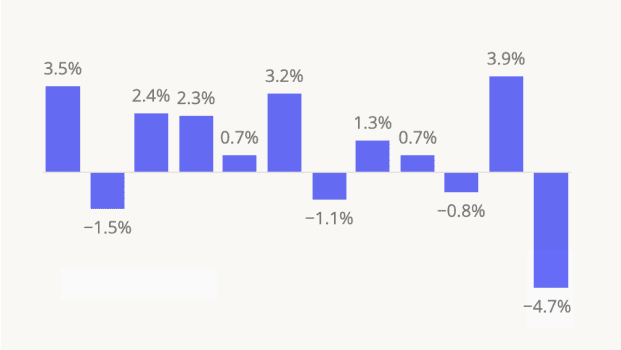2024 represented a year of transformation in U.S. luxury retail. After years of evading the impact of inflation and changing consumer behavior, ultra luxury brands and retailers began experiencing some of the challenges plaguing the wider retail space over this past year. Consumers of all income groups pulled back on spending and shifted focus towards value, which is inherently at odds with the luxury retail experience. Despite the aspirational nature of social media, many consumers who had been testing the waters of the luxury market can’t sustain their demand. There’s also been a rebound of the “accessible” luxury market, with brands like Coach and other smaller chains capturing the attention of the consumer.
How did 2024 end in terms of luxury retail visitation? Generally, visitation to luxury retail brands was down throughout the year, with visits for 2024 as a whole down 4% year-over-year. This is in stark contrast to the growth in visits we observed in 2022 and 2023, a clear signal that there’s been a shift in consumer demand for luxury brands here in the U.S. The elasticity of luxury visits waned in 2024, which could be attributed to a few factors; changes in demand for specific brands this past year or lower general demand for the categories.
The most interesting shift this past year was in the segmentation of visitors to luxury retailers. Using PersonaLive visitor segments, we observed changes in the types of demographic consumer segments visiting luxury brands. The percentage of visits by Ultra Wealthy Families increased over the past three years, with the cohort making up 20% of luxury retailers’ captured market in 2024, the largest of any visitor segment.
At the same time, we noted decreases in the share of Near-Urban Diverse Families, Young Urban Singles, and City Hopefuls in luxury retailers’ trade areas. These groups fall more into the aspirational customer segment for luxury brands, meaning that they might not be frequent shoppers or may have saved up for a large purchase. Luxury retailers now have to rely more on their traditional consumer base and have narrowed their pool of potential visitors.
Beyond the retailers themselves, luxury shopping centers also saw visitation decelerate in 2024. Looking at three key luxury centers, Americana Manhasset in Manhasset, NY, Bal Harbour Shops in Miami, and Highland Park Village in Dallas, each center slowed down compared to prior years. These shopping centers house ultra luxury brands, such as Hermes, Dior, and Chanel, as well as new luxury entrants like LoveShackFancy and beauty chain Bluemercury as well as upscale dining options; despite this strong mix of tenants, it’s clear that changing consumer behavior has impacted these centers, even those that still saw growth early in the year.
There weren’t any observable changes in visitor behavior in terms of how long visitors stayed or what day of the week they visited. All three luxury shopping centers rely heavily on weekend visitors, and as consumers pull back on the frequency of discretionary purchases, there might be less incentive to visit overall. More than 50% of Americana Manhasset and Highland Park Village’s trade area is made up of Ultra Wealthy Families, and that high concentration that once benefited luxury retailers may now present hurdles in sustaining traffic growth.
Luxury brands, despite the changing tides, are the true retail trend setters, and have the ability to pivot as needed to meet changing consumer demands. In 2024, we saw the triumphant rise of brands such as Miu Miu, Louis Vuitton and Hermes as consumers concentrated their purchases around the hottest labels. The luxury market faces more uncertainty in 2025 as the consumer fluctuates to adapt to changes across the U.S. and the need to provide a high touch experience and inherent value is critical to garner the attention of shoppers.




.png)
.png)

.png)
.png)














.svg)